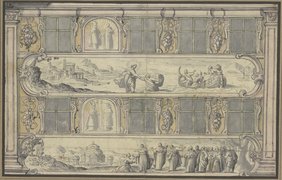In the genre of large-scale wall or façade painting, a close connection between the imperial city of Augsburg and the residential city of Munich can be observed for the decades around 1600. For Munich, the artists Johann Melchior Bocksberger (c. 1530-1587), Christoph Schwarz (c. 1548-1592) and their pupils Hans Krumper (c. 1570-1634), Georg Beham (also: Pecham (1568-1604)) and Christoph Zimmermann are particularly worthy of mention as façade painters during this period. Important artists such as Johann Rottenhammer (1564/1565-1625) or Johann Matthias Kager (1575-1634), who became a licensed painter in Augsburg in 1604, were in turn drawn to Augsburg. In connection with a sheet of a façade design from the Haupts Collection, Georg Beham should be mentioned here. Beham had, pro forma under the aegis of the local painter Zimprecht Bauser, been able to execute a monumental façade painting for the Augsburg merchant Martin Pfeiffelmann in 1594 (so-called 'Pfeiffelmannhaus', today Philippine-Welser-Straße 13, rebuilt after the Second World War, façade painting no longer preserved). In the structure of the mock architecture and the integration of the pictorial scenes, as well as in some details of the decorative motifs, the design from the Haupt Collection is very reminiscent of Beham's façade of this house and is therefore probably a direct successor. Heinrich Geissler, art historian and expert on German drawings of the 16th and 17th centuries, classified the sheet in 1977 in a note to the curator of the collection at the time, Ulrich Ott, as "certainly Munich" and added "perhaps Thomas Hoffmann"[?] (c. 1600-1646). Indeed, the biblical scenes, which are untypical for Augsburg paintings, and the clerical references (monk, bishop and cardinal) rather point to a design for a building in Munich – but the dependence on the Augsburg model, especially in the structural concept, is obvious.
Simon Paulus

